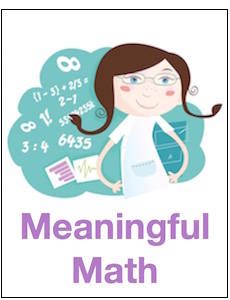Teaching Math Virtually: Learning as We Go
A MiddleWeb Blog
 I have been fortunate enough to have been provided a whole tool chest of technology resources. Right now, that’s not the issue.
I have been fortunate enough to have been provided a whole tool chest of technology resources. Right now, that’s not the issue.
The problem is that my students are not responding and engaging with the tools I have.
I’ll be the first to admit that students are having to be more disciplined and self motivated than ever before. And if I am being honest, I’m not sure my teenage self would have done a great job with distance learning.
So I am going to share what I have slowly and painfully learned about combining distance learning and teaching math. Let me just say, I have a lot to learn.
if you have been teaching virtually for a while, you may be shaking your head at me before you reach the end of this post.
On a positive note, the majority of my students have been eager, kind, and helpful. They are struggling just like I am. They motivate me to try harder every day.
So I want to share what I’ve learned so far teaching in a hybrid model (some students always virtual; others virtual part of the week). I would be very grateful if you would share your pointers, tips and experiences in the comments below.
Lesson 1: Don’t Assume Students Know About Technology
I always thought it was a given that my students were much better at technology than people in my generation, and yet I have found that they struggle with things I think are pretty basic, such as how to copy and paste in a document, or how to save a file as a google doc. I realize now that they are wizards at technology if it’s something that interests them.
I started out quickly explaining or in some cases just assuming that they knew how to turn in assignments or find resources. I’ve learned I need to slowly and carefully demonstrate how to complete the basic technology requirements for our distance learning. It is a fact that secondary students need to hear something up to 100 times before it sinks in! That might be an exaggeration, but not by much!
Lesson 2: Don’t Leave Anything Unsaid
There have been so many things that I thought they would know without me having to spell it out,. I was wrong. For instance, when I wrote examples on the board (for my face-to-face students) in the past, they just knew they should be taking notes. Well….

We have Google meets with all of our students on Friday. I do not require that they turn their camera on because I don’t want them to stress out about what their rooms look like or what they are wearing, but it’s difficult to try to talk without seeing anyone. When I’m talking to a bunch of black squares, I really feel like I’m talking to myself.
Last Friday I asked a question and one student turned their camera on and answered the question. Before I thought, I said “Thank you so much for turning your camera on. It is so nice to talk to a person.” It was so sweet. One by one cameras starting coming on, not all of them but most. Students really are well-meaning for the most part, and they really didn’t think about what it was like for me talking to all of those empty boxes.
Lesson 3: Be Firm, Consistent, and Fair
At the beginning of the year I was eager to make my students feel safe and comfortable. I was so determined not to stress them out that I think I came across as ambivalent, giving students the impression that it didn’t really matter if they did their assignments. I am realizing that in addition to being kind, I also have to be firm and consistent. Students need clear-cut and unequivocal instructions right now.
Lesson 4: Don’t Take Shortcuts. Train Your Students to Be Self Sufficient
Often students ask me a question that I have answered in Announcements, in our module, and in other resources that are available to them. Many times I will just answer their question to save time. But the better thing to do is to refer them to where the information is located.
Although a quick answer saves time, it’s not quicker in the long run. It is much better for them and me if I train them to be self-sufficient. If virtual learning continues for a while (or comes around again) students need to be able to access information for themselves.
That means I have the responsibility to make the information available to them in a logical way that is simple for them to access. To that end, I am constantly retooling and adjusting how I organize my online information.
I have several students I trust to answer me honestly and count on them to help me fine-tune my system. I have begun spending a few minutes of class time every day going over the logistics of where to find information, how to turn in assignments, etc.
Lesson 5: Hit Pause Before Replying
I am inundated with emails every day from students and parents. The emails come from my hybrid students who I see two days a week and from my virtual students who are never on campus. Often the parents who email me are stressed and even panicked after seeing their child’s grades.
Many times the emails are requesting extensions, retakes for tests, bonus points, or extra credit. After weeks of this, it can make you weary. At times I am tempted to say “no” right off the bat, but that’s not the right thing to do.
Students and parents are facing extenuating circumstances just like teachers are, so I am trying to take a minute before I reply. I am always glad when I do. Although I can’t always give everyone what they want, I can try to treat everyone fairly with a little extra compassion right now.
I used to worry we’d be replaced with technology
I don’t worry about that anymore. Almost every student I have asked has said they prefer to be in a face-to-face class with their teacher – not doing distance learning. And I have to agree: It is a pretty special thing when a teacher and a student can sit in a room and learn together. And I will never take it for granted again.

































A very helpful article! Thank you!
Your article was very informative and right on time. Thank you for the tips. I, too, found out never assume your students know they should be taking notes. Make expectations clear and say them often🙂